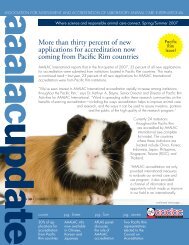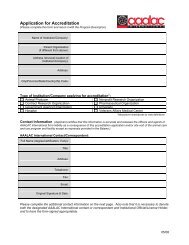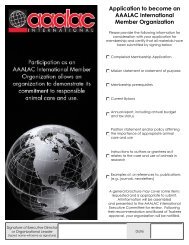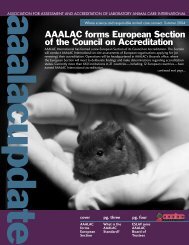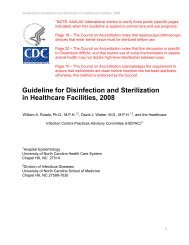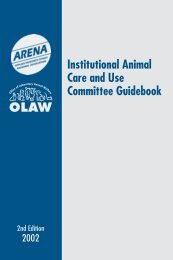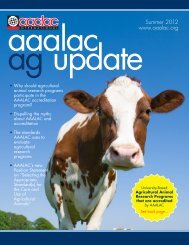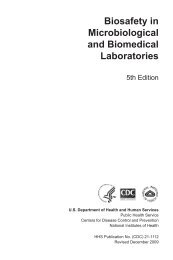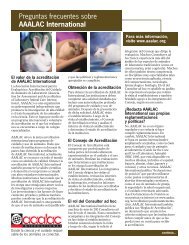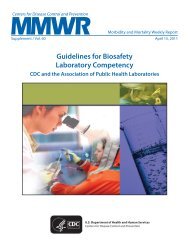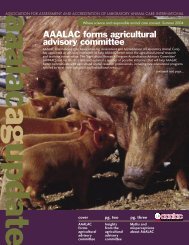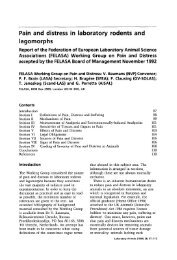32 CHAPTER 4(Feh <strong>and</strong> de Mazieres, 1993), suggest<strong>in</strong>g a role <strong>in</strong> reduc<strong>in</strong>ganxiety. Mutual groom<strong>in</strong>g is rarely per<strong>for</strong>med bystallions (Crowell-Davis et al., 1986), except follow<strong>in</strong>gperiods <strong>of</strong> social deprivation (Christensen et al., 2002).In contrast, colts <strong>and</strong> geld<strong>in</strong>g are highly motivated toplay with each o<strong>the</strong>r. When housed <strong>in</strong> extensive conditions,colts per<strong>for</strong>m hourly play bouts, such as mockfight<strong>in</strong>g, whereas mares do not typically engage <strong>in</strong> thisbehavior (Sigurjonsdottir et al., 2003).Because aggression <strong>and</strong> play can result <strong>in</strong> <strong>in</strong>juries,stallions are typically housed s<strong>in</strong>gly. Aggression is <strong>in</strong>fluencedby reproductive status, with greater aggression <strong>in</strong>established groups occurr<strong>in</strong>g <strong>in</strong> <strong>the</strong> breed<strong>in</strong>g <strong>and</strong> foal<strong>in</strong>gseason (Grogan <strong>and</strong> McDonnell, 2005). In mixedgroups, mares display more aggression <strong>in</strong> <strong>the</strong> postparturientperiod, primarily <strong>in</strong> <strong>the</strong> <strong>for</strong>m <strong>of</strong> <strong>in</strong>terventionsto protect foals from barren mares <strong>and</strong> geld<strong>in</strong>gs(Rutberg <strong>and</strong> Greenberg, 1990; van Dierendonck et al.,2004). Similarly dur<strong>in</strong>g feed<strong>in</strong>g trials, yearl<strong>in</strong>g femalesper<strong>for</strong>m significantly more agonistic <strong>in</strong>teractions (e.g.,head threats, bit<strong>in</strong>g, kick<strong>in</strong>g) than geld<strong>in</strong>gs <strong>of</strong> <strong>the</strong> sameage, likely because <strong>of</strong> circulat<strong>in</strong>g steroid levels at estrus(Motch et al., 2007).When horses are housed s<strong>in</strong>gly or <strong>in</strong> isolation facilities,distress associated with social deprivation can bealleviated by provid<strong>in</strong>g visual contact with o<strong>the</strong>r equids.Weav<strong>in</strong>g <strong>and</strong> head-nodd<strong>in</strong>g stereotypies, which are associatedwith frustration (Mills <strong>and</strong> Riezebos, 2005), aresignificantly reduced when horses can see o<strong>the</strong>r equidsthrough grilled side w<strong>in</strong>dows (Cooper et al., 2000), orwhen mirrors (McAfee et al., 2002) or life-sized posterimages <strong>of</strong> a horse’s face (Mills <strong>and</strong> Riezebos, 2005) areplaced <strong>in</strong> <strong>the</strong> stalls. Lateral visual contact appears to beimportant, because weav<strong>in</strong>g is significantly more likelyto occur when stalls are arranged face-to-face than sideby-side(N<strong>in</strong>omiya et al., 2007).In <strong>the</strong> absence <strong>of</strong> equids, horses readily <strong>for</strong>m socialrelationships with o<strong>the</strong>r species, such as goats, dogs,<strong>and</strong> humans. Intensively managed horses detect <strong>and</strong> respondto subtle <strong>in</strong>dicators <strong>of</strong> emotional state <strong>and</strong> confidence<strong>in</strong> <strong>the</strong>ir human h<strong>and</strong>lers, elicit<strong>in</strong>g both fearfulness<strong>and</strong> calmness (Chamove et al., 2002; von Borstel,2007; von Borstel et al., 2007). Horses accept be<strong>in</strong>ggroomed by humans; reductions <strong>in</strong> heart rate that occurwhen horses per<strong>for</strong>m mutual groom<strong>in</strong>g (Feh <strong>and</strong> deMazieres, 1993) are also observed when humans brushor scratch <strong>the</strong> wi<strong>the</strong>rs <strong>and</strong> neck regions (Lynch et al.,1974; Hamas et al., 1996). However, this positive associationwith tactile stimulation by humans appears tobe learned ra<strong>the</strong>r than <strong>in</strong>nate (Henry et al., 2006), <strong>and</strong><strong>in</strong> <strong>the</strong> absence <strong>of</strong> positive <strong>in</strong>teractions, foals beg<strong>in</strong> toavoid humans at 3 wk <strong>of</strong> age (Lansade et al., 2007).Physical Enrichment. Horses provided access to paddocksor pasture can alleviate <strong>for</strong>ag<strong>in</strong>g motivationthrough graz<strong>in</strong>g, but horses also benefit from opportunitiesto exercise, with activity positively associatedwith paddock size (Jorgensen <strong>and</strong> Boe, 2007). Horsesappear to be motivated to per<strong>for</strong>m exercise <strong>in</strong> its ownright, with motivation build<strong>in</strong>g up <strong>and</strong> compensatoryactivity per<strong>for</strong>med after periods <strong>of</strong> deprivation (Houptet al., 2001; Christensen et al., 2002; Chaya et al.,2006). Fur<strong>the</strong>rmore, horses provided with turn-out displaymore varied roll<strong>in</strong>g behavior, which is believed tobe associated with com<strong>for</strong>t (Hansen et al., 2007). Ina study <strong>of</strong> rac<strong>in</strong>g horses, benefits <strong>of</strong> regular turn-outalso <strong>in</strong>cluded less aggression directed toward h<strong>and</strong>lers(Drissler et al., 2006) <strong>and</strong> superior race <strong>and</strong> career per<strong>for</strong>mance(Drissler, 2006).Occupational Enrichment. In <strong>the</strong> absence <strong>of</strong> turn<strong>in</strong>gout <strong>in</strong> paddocks or pastures, horses can direct playbehavior toward “toys” placed <strong>in</strong> <strong>the</strong> stall. Several commerciallyavailable products such as <strong>the</strong> large durableballs designed to be used with stabled horses can beprovided, as well as home-made devices such as plasticjugs hang<strong>in</strong>g on ropes. Scientific evidence regard<strong>in</strong>g <strong>the</strong>efficacy <strong>of</strong> <strong>the</strong>se products is lack<strong>in</strong>g.Sensory Enrichment. In many stables, it is common<strong>for</strong> background noise to be provided by a radio, with<strong>the</strong> assumption that this provides a calm<strong>in</strong>g effect on<strong>the</strong> horses <strong>and</strong> alleviates boredom. However, <strong>the</strong> presenceor type <strong>of</strong> music was not found to significantlyaffect <strong>the</strong> behavior <strong>of</strong> ponies subjected to short-termisolation distress (Houpt et al., 2000). These authorsspeculate that background music may <strong>in</strong>directly affectequ<strong>in</strong>e behavior through <strong>the</strong> attitudes <strong>of</strong> <strong>the</strong>ir humancaretakers. Conversely, a syn<strong>the</strong>tic Equ<strong>in</strong>e AppeasementPheromone product is commercially available,<strong>and</strong> <strong>the</strong>re is m<strong>in</strong>imal evidence that this product effectivelyreduces behavioral <strong>and</strong> physiologic fear responses<strong>of</strong> horses subjected to a stressful situation (Falewee etal., 2006).Nutritional Enrichment. Opportunities to <strong>for</strong>age providesignificant enrichment <strong>for</strong> stabled horses. Horsestypically spend 10 to 12 h graz<strong>in</strong>g per day (Ralston,1984), <strong>and</strong> lactat<strong>in</strong>g mares spend 70% <strong>of</strong> <strong>the</strong>ir timegraz<strong>in</strong>g on pasture (Crowell-Davis et al., 1985). In <strong>the</strong>absence <strong>of</strong> <strong>for</strong>ag<strong>in</strong>g material, horses frequently may direct<strong>for</strong>ag<strong>in</strong>g toward <strong>the</strong> stall bedd<strong>in</strong>g or stall surfaces(Drissler et al., 2006), or may display oral stereotypiessuch as crib-bit<strong>in</strong>g, w<strong>in</strong>d-suck<strong>in</strong>g, sham chew<strong>in</strong>g, haireat<strong>in</strong>g, <strong>and</strong> wood chew<strong>in</strong>g/lick<strong>in</strong>g. Undesirable oralbehavior can be addressed by provid<strong>in</strong>g at least 6.8kg <strong>of</strong> hay per day (McGreevy et al., 1995), provid<strong>in</strong>gmultiple <strong>for</strong>ages (Goodw<strong>in</strong> et al., 2002; Thorne et al.,2005), <strong>and</strong> divid<strong>in</strong>g concentrate feed <strong>in</strong>to smaller <strong>and</strong>more frequent meals throughout <strong>the</strong> day (Cooper etal., 2005). Horses provided with straw bedd<strong>in</strong>g per<strong>for</strong>mless stereotypic behavior than those bedded on paperor shav<strong>in</strong>gs (Cooper et al., 2005). Several food toys arecommercially available, which horses manipulate toobta<strong>in</strong> high-fiber food pellets. These food-balls result<strong>in</strong> <strong>in</strong>creased <strong>for</strong>ag<strong>in</strong>g time (W<strong>in</strong>skill et al., 1996) <strong>and</strong>reduced stereotypic behavior (Henderson <strong>and</strong> Waran,2001). Toys with round or polyhedral designs are mosteffective (Goodw<strong>in</strong> et al., 2007). These toys can be provided<strong>in</strong> <strong>the</strong> manger to prevent horses from <strong>in</strong>gest<strong>in</strong>g
pathogens <strong>and</strong> nonnutritive materials from <strong>the</strong> stallbedd<strong>in</strong>g.PoultrySocial Enrichment. Socialization <strong>of</strong> poultry with humanscan be carried out with relative ease by frequentexposure to k<strong>in</strong>d, gentle care (Jones, 1996). Even briefperiods <strong>of</strong> h<strong>and</strong>l<strong>in</strong>g, beg<strong>in</strong>n<strong>in</strong>g at <strong>the</strong> youngest possibleage, confer advantages <strong>for</strong> ease <strong>of</strong> later h<strong>and</strong>l<strong>in</strong>g <strong>of</strong>birds <strong>and</strong> <strong>in</strong>crease feed efficiency, body weights, <strong>and</strong> antibodyresponses (Gross <strong>and</strong> Siegel, 1983). In addition,Gross <strong>and</strong> Siegel (1982) found that positively socializedchickens had reduced responses to stressors <strong>and</strong> thatresistance to most diseases tested was better than that<strong>of</strong> birds that had not been socialized.Occupational Enrichment. A primary method <strong>for</strong> promot<strong>in</strong>gexercise <strong>in</strong> poultry is <strong>the</strong> provision <strong>of</strong> perches oro<strong>the</strong>r elevated areas that encourage <strong>the</strong> use <strong>of</strong> verticalspace <strong>in</strong> <strong>the</strong> enclosure. Egg-lay<strong>in</strong>g stra<strong>in</strong>s <strong>of</strong> chickensare highly motivated to use perches at night (Olsson<strong>and</strong> Keel<strong>in</strong>g, 2002), <strong>and</strong> <strong>the</strong> entire flock (100% <strong>of</strong> hens)will utilize perches at night if sufficient perch space isprovided (Appleby et al., 1993; Olsson <strong>and</strong> Keel<strong>in</strong>g,2002). When hens are housed <strong>in</strong> floor pens, perches allow<strong>the</strong>m to roost com<strong>for</strong>tably with a m<strong>in</strong>imum <strong>of</strong> disturbance<strong>and</strong> provide <strong>the</strong>m with an opportunity to seekrefuge from o<strong>the</strong>r birds to avoid cannibalistic peck<strong>in</strong>g(Wechsler <strong>and</strong> Huber-Eicher, 1998). Perches can alsom<strong>in</strong>imize bird flight<strong>in</strong>ess <strong>and</strong> fearfulness (Brake, 1987),<strong>and</strong> <strong>the</strong> exercise facilitated by vertical movement canimprove bone strength (Whitehead, 2004). Early exposureto perches dur<strong>in</strong>g rear<strong>in</strong>g facilitates perch<strong>in</strong>g behavior<strong>in</strong> adult birds (Faure <strong>and</strong> Jones, 1982; Heikkliäet al., 2006).Poults <strong>and</strong> young broiler chickens also use perchesbut use tends to decrease when <strong>the</strong> birds are older. Atlater stages <strong>of</strong> <strong>the</strong> production cycle, perches are usedmuch less frequently by broilers <strong>and</strong> turkeys than bylay<strong>in</strong>g hens (LeVan et al., 2000; Martrenchar et al.,2001). Because <strong>of</strong> <strong>the</strong>ir body size <strong>and</strong> con<strong>for</strong>mation,older turkeys <strong>and</strong> broiler chickens need to be providedwith lower perches <strong>of</strong> a shape <strong>and</strong> size that allow <strong>the</strong>mto easily access <strong>the</strong> perches <strong>and</strong> to balance properlywhen perch<strong>in</strong>g. For older turkeys it advisable to locate<strong>the</strong> perches high enough that turkeys on <strong>the</strong> groundcannot peck <strong>and</strong> pull <strong>the</strong> fea<strong>the</strong>rs <strong>of</strong> perch<strong>in</strong>g birds;ramps can be <strong>in</strong>stalled <strong>in</strong> front <strong>of</strong> <strong>the</strong>se higher perchesto facilitate access (Council <strong>of</strong> Europe, 2006). Strawbales can also be added to pens to provide an elevatedsurface <strong>for</strong> broilers <strong>and</strong> turkeys (Council <strong>of</strong> Europe,2006), but aga<strong>in</strong> ramps may need to be <strong>in</strong>stalled so thatolder birds can easily access <strong>the</strong>se. Because straw is alsoused as a <strong>for</strong>ag<strong>in</strong>g substrate, however, <strong>the</strong> bales maybe rapidly pecked apart <strong>and</strong> scattered (Martrenchar etal., 2001).In general, perches should be free <strong>of</strong> sharp edges, <strong>of</strong> asize that can be readily gripped by <strong>the</strong> claws but largeENVIRONMENTAL ENRICHMENTenough <strong>in</strong> diameter that <strong>the</strong> bird’s toenails do not damageits footpad, <strong>and</strong> made <strong>of</strong> a material that is nonslipbut that can be cleaned. Perches soiled with feces are amajor contribut<strong>in</strong>g factor to <strong>the</strong> development <strong>of</strong> a pa<strong>in</strong>fulfoot condition, bumblefoot, <strong>in</strong> floor-housed poultry,so it is important that perches be properly designed tom<strong>in</strong>imize this problem. In addition, hens may developdeviated keel bones from rest<strong>in</strong>g on perches, althoughit is unknown if this condition is pa<strong>in</strong>ful (Tauson <strong>and</strong>Abrahamsson, 1996). Lay<strong>in</strong>g hens prefer high perches.However, hens tend to develop osteoporosis <strong>and</strong> thismakes perch placement (e.g., spac<strong>in</strong>g between percheswhen multiple perches are provided) critical to ensurethat <strong>the</strong> hens can navigate <strong>the</strong> perches without break<strong>in</strong>gbones dur<strong>in</strong>g l<strong>and</strong><strong>in</strong>gs (see Keel<strong>in</strong>g, 2004).Ducks will swim if water <strong>of</strong> sufficient depth is provided.If swimm<strong>in</strong>g water is made available to duckl<strong>in</strong>gs,<strong>the</strong> water should be very shallow so that <strong>the</strong> duckl<strong>in</strong>gsdo not drown, <strong>and</strong> care must be taken until <strong>the</strong>ir waterpro<strong>of</strong>fea<strong>the</strong>rs emerge to ensure that <strong>the</strong>y do notbecome soaked <strong>and</strong> chilled (BVAAWF/FRAME/RSP-CA/UFAW Jo<strong>in</strong>t Work<strong>in</strong>g Group on Ref<strong>in</strong>ement, 2001;Council <strong>of</strong> Europe, 2006).Physical EnrichmentNestboxes: The most important physical enrichment<strong>for</strong> lay<strong>in</strong>g hens is a nestbox. Egg lay<strong>in</strong>g <strong>in</strong>volves a complexsequence <strong>of</strong> behaviors, <strong>in</strong>clud<strong>in</strong>g search<strong>in</strong>g <strong>for</strong> asuitable site <strong>in</strong> which to lay an egg <strong>and</strong> <strong>the</strong>n prepar<strong>in</strong>gthat site by peck<strong>in</strong>g, tread<strong>in</strong>g, <strong>and</strong> mold<strong>in</strong>g <strong>the</strong> substrateto create a nest. Lay<strong>in</strong>g hens that are not providedwith a nest site (e.g., those housed <strong>in</strong> conventionalcages) may show agitated pac<strong>in</strong>g behavior dur<strong>in</strong>g <strong>the</strong>nest-seek<strong>in</strong>g phase, which has been <strong>in</strong>terpreted as evidence<strong>of</strong> frustration (Appleby et al., 2004).Hens place a high value on access<strong>in</strong>g nests, <strong>and</strong> <strong>the</strong>irmotivation <strong>for</strong> nest use <strong>in</strong>creases greatly as <strong>the</strong> time <strong>of</strong>oviposition approaches (Cooper <strong>and</strong> Albentosa, 2003).Even hens without prior exposure to nests show a strongmotivation to use nests <strong>for</strong> egg lay<strong>in</strong>g (Cooper <strong>and</strong> Appleby,1995; 1997). Lay<strong>in</strong>g hens also generally preferenclosed nest<strong>in</strong>g sites to ones that are more open (Appleby<strong>and</strong> McRae, 1986; Cooper <strong>and</strong> Appleby, 1997).Provid<strong>in</strong>g an appropriate substrate <strong>in</strong> <strong>the</strong> nestbox isalso important to allow <strong>for</strong> nest-build<strong>in</strong>g behavior (Applebyet al., 2004).There have been few experimental studies <strong>of</strong> prelay<strong>in</strong>gbehavior or nest-site selection <strong>in</strong> ei<strong>the</strong>r ducks orturkeys. However, it is likely that <strong>the</strong>y have a similarlystrong motivation to lay <strong>the</strong>ir eggs <strong>in</strong> a nest box.There are many different types <strong>of</strong> nestboxes availablecommercially <strong>and</strong> most have been used successfully <strong>in</strong>both <strong>in</strong>dustry <strong>and</strong> research sett<strong>in</strong>gs <strong>for</strong> ducks <strong>and</strong> turkeys,suggest<strong>in</strong>g that <strong>the</strong> important features <strong>of</strong> a nestto <strong>the</strong>se species, as <strong>for</strong> lay<strong>in</strong>g hens, are fairly simple(Appleby et al., 2004).33
- Page 1 and 2: Guide for the Care and Useof Agricu
- Page 3 and 4: Guide Revision Committees for the F
- Page 5 and 6: Chapter 6: Beef Cattle 61Facilities
- Page 7: PrefaceThis is the third edition of
- Page 10 and 11: 2 CHAPTER 1The IACUC should meet at
- Page 12 and 13: 4 CHAPTER 1tion Center at the Natio
- Page 14 and 15: 6 CHAPTER 1Disposition of Animal Cl
- Page 16 and 17: Chapter 2: Agricultural Animal Heal
- Page 18 and 19: 10 CHAPTER 2and behavioral health e
- Page 20 and 21: 12 CHAPTER 2care attendants or rese
- Page 22 and 23: 14 CHAPTER 2exposed to these chemic
- Page 24 and 25: Chapter 3: Husbandry, Housing, and
- Page 26 and 27: 18 CHAPTER 3Most agricultural anima
- Page 28 and 29: 20 CHAPTER 3gases, particulates, an
- Page 30 and 31: 22 CHAPTER 3in pairs or groups when
- Page 32 and 33: 24 CHAPTER 3screened with 1.3-cm (0
- Page 34 and 35: 26 CHAPTER 3priate, and institution
- Page 36 and 37: 28 CHAPTER 3ings and Deliberations.
- Page 38 and 39: Chapter 4: Environmental Enrichment
- Page 42 and 43: 34 CHAPTER 4Substrate: The provisio
- Page 44 and 45: 36 CHAPTER 4mize regrouping and soc
- Page 46 and 47: 38 CHAPTER 4not especially attracte
- Page 48 and 49: 40 CHAPTER 4Croney, C. C., K. M. Ad
- Page 50 and 51: 42 CHAPTER 4Meunier-Salaün, M. C.,
- Page 52 and 53: 44 CHAPTER 4Wilson, S. C., F. M. Mi
- Page 54 and 55: 46 CHAPTER 5dling facility in the f
- Page 56 and 57: 48 CHAPTER 5Table 5-1. Visual distr
- Page 58 and 59: 50 CHAPTER 5Animals should be handl
- Page 60 and 61: 52 CHAPTER 5be given during conditi
- Page 62 and 63: 54 CHAPTER 5mercial broiler farms,
- Page 64 and 65: 56 CHAPTER 5The condition of the an
- Page 66 and 67: 58 CHAPTER 5Arnold, G. W. 1977. An
- Page 68 and 69: 60 CHAPTER 5for veterinary and husb
- Page 70 and 71: 62 CHAPTER 6managers of confined ca
- Page 72 and 73: 64 CHAPTER 6Cold housing can be pro
- Page 74 and 75: 66 CHAPTER 6HUSBANDRYAdequate care
- Page 76 and 77: 68 CHAPTER 6ately to perform a caes
- Page 78 and 79: 70 CHAPTER 6minimum amount of time
- Page 80 and 81: 72 CHAPTER 6Ensminger, M. E. 1970.
- Page 82 and 83: Chapter 7: Dairy CattleDairy cattle
- Page 84 and 85: 76 CHAPTER 7Table 7-1. Recommended
- Page 86 and 87: 78 CHAPTER 7ties should be provided
- Page 88 and 89: 80 CHAPTER 7quent feeding, and exce
- Page 90 and 91:
82 CHAPTER 7hanced sensitivity to h
- Page 92 and 93:
84 CHAPTER 7effective for removing
- Page 94 and 95:
86 CHAPTER 7Albright, J. L. 1978. S
- Page 96 and 97:
88 CHAPTER 7Murphy, M. R., C. L. Da
- Page 98 and 99:
Chapter 8: HorsesMost horses are us
- Page 100 and 101:
92 CHAPTER 8Temperature and Ventila
- Page 102 and 103:
94 CHAPTER 8tritional programs for
- Page 104 and 105:
96 CHAPTER 8WaterClean water should
- Page 106 and 107:
98 CHAPTER 8bots (Gastrophilus inte
- Page 108 and 109:
100 CHAPTER 8STANDARD AGRICULTURALP
- Page 110 and 111:
102 CHAPTER 8of Animals. C. McGowan
- Page 112 and 113:
104 CHAPTER 9dom of movement, runni
- Page 114 and 115:
106 CHAPTER 92006). Developing bree
- Page 116 and 117:
108 CHAPTER 9Table 9-3. Minimum fee
- Page 118 and 119:
110 CHAPTER 9Table 9-7. Minimum dri
- Page 120 and 121:
112 CHAPTER 9Table 9-10. Minimum fl
- Page 122 and 123:
114 CHAPTER 9Table 9-12. Minimum fl
- Page 124 and 125:
116 CHAPTER 9ery effort should be m
- Page 126 and 127:
118 CHAPTER 9guides, available from
- Page 128 and 129:
120 CHAPTER 9nutritive pecking decr
- Page 130 and 131:
122 CHAPTER 9rapidly fragmented by
- Page 132 and 133:
124 CHAPTER 9Brambell, F. W. R. 196
- Page 134 and 135:
126 CHAPTER 9Hughes, B. O., and M.
- Page 136 and 137:
128 CHAPTER 9chickens grown with tw
- Page 138 and 139:
130 CHAPTER 10Table 10-1. Recommend
- Page 140 and 141:
132 CHAPTER 10prevented or minimize
- Page 142 and 143:
134 CHAPTER 10and well-being (Matte
- Page 144 and 145:
136 CHAPTER 10via colostrum (de la
- Page 146 and 147:
138 CHAPTER 10thoroughly at the beg
- Page 148 and 149:
140 CHAPTER 10Ames, D. R., J. E. Ne
- Page 150 and 151:
142 CHAPTER 102006. Semen and repro
- Page 152 and 153:
144 CHAPTER 11Table 11-1. Recommend
- Page 154 and 155:
146 CHAPTER 11vided in the creep ar
- Page 156 and 157:
148 CHAPTER 11Table 11-2. Minimum f
- Page 158 and 159:
150 CHAPTER 11are kept in small gro
- Page 160 and 161:
152 CHAPTER 11sonable to consolidat
- Page 162 and 163:
154 CHAPTER 11Blackshaw, J. K., F.
- Page 164 and 165:
156 CHAPTER 11populations structure
- Page 166 and 167:
Appendix 2Table A-1. Zoonotic disea
- Page 168 and 169:
IndexAAABP (American Association of
- Page 170 and 171:
162 INDEXcold climates. See also te
- Page 172 and 173:
164 INDEXdairy, 137disbudding of, 1
- Page 174 and 175:
166 INDEXmisters, 19mites, 98Model
- Page 176 and 177:
168 INDEXin horse stalls, 90in poul



